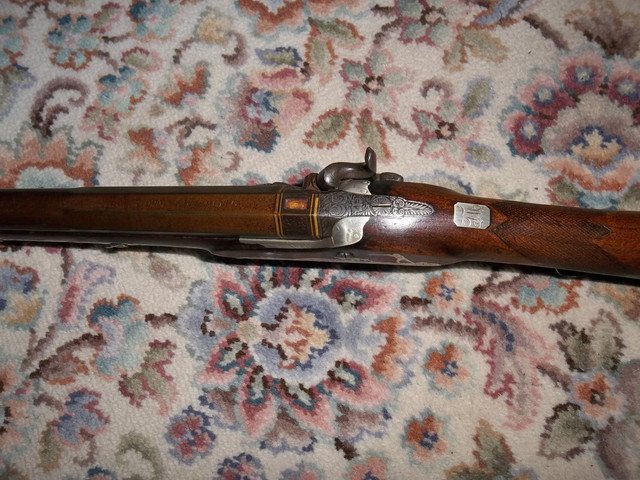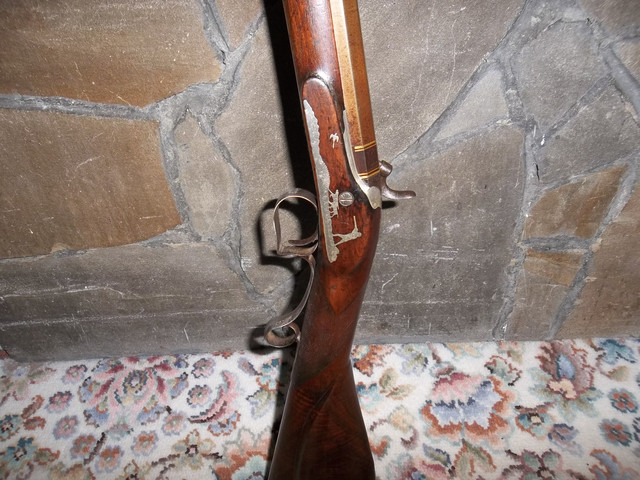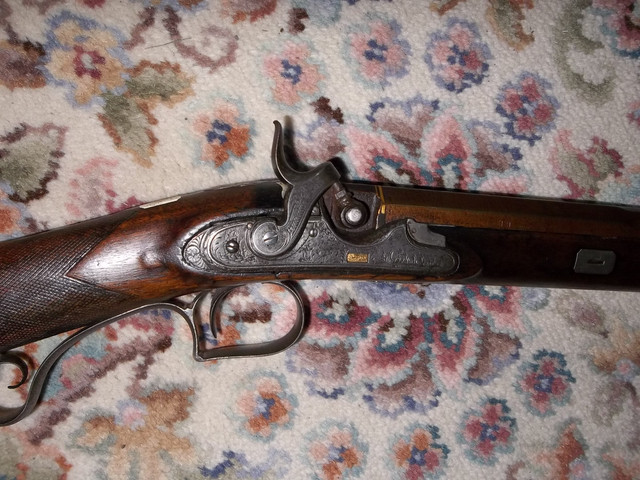-
Friends, our 2nd Amendment rights are always under attack and the NRA has been a constant for decades in helping fight that fight.
We have partnered with the NRA to offer you a discount on membership and Muzzleloading Forum gets a small percentage too of each membership, so you are supporting both the NRA and us.
Use this link to sign up please; https://membership.nra.org/recruiters/join/XR045103
You are using an out of date browser. It may not display this or other websites correctly.
You should upgrade or use an alternative browser.
You should upgrade or use an alternative browser.
English SxS rifle
- Thread starter fleener
- Start date

Help Support Muzzleloading Forum:
This site may earn a commission from merchant affiliate
links, including eBay, Amazon, and others.
Fleener,
I'd have to look about the lock marks. I haven't seen a Stanton lock initialed that way, but haven't seen them all by any means!
I think the silver is to protect the wood, but it Is unusual to have it below the barrels.
Normally we see it behind the breeches to protect the wood from charring.
Re. locks;
I have some lovely locks, and it transpires they were made by Joseph Jones. To me a complete unknown, but V high quality and altogether delightful.
With locks, (There were a Great many lockmakers in Wolverhampton) Quality is where you find it!...and you have found it here with yours, whoever it is!
I will ask Bill Curtis, as he has more refence books than I do.
It may be in Donald Dallas' "Boss" book, I'll check, but am in the middle of hay-making.
I'd have to look about the lock marks. I haven't seen a Stanton lock initialed that way, but haven't seen them all by any means!
I think the silver is to protect the wood, but it Is unusual to have it below the barrels.
Normally we see it behind the breeches to protect the wood from charring.
Re. locks;
I have some lovely locks, and it transpires they were made by Joseph Jones. To me a complete unknown, but V high quality and altogether delightful.
With locks, (There were a Great many lockmakers in Wolverhampton) Quality is where you find it!...and you have found it here with yours, whoever it is!
I will ask Bill Curtis, as he has more refence books than I do.
It may be in Donald Dallas' "Boss" book, I'll check, but am in the middle of hay-making.
52Bore
40 Cal.
- Joined
- Dec 14, 2016
- Messages
- 682
- Reaction score
- 983
Fleener:
My cased Alex Henry Percussion Double has the same silver plates at the breech. I believe they are there to protect this area, looks better than dinged up wood caused over the years from assembling the rifle.
Good job on the regulation on such a nice piece.

My cased Alex Henry Percussion Double has the same silver plates at the breech. I believe they are there to protect this area, looks better than dinged up wood caused over the years from assembling the rifle.
Good job on the regulation on such a nice piece.

These wood protector plates (usually Nickel on nornmal quality guns) were common with Bar in the Wood locks as shewn on the Henry in your post No.23 as the wood is minimal under the barrels.
I have an Ezikiel Backer Double 22 bore Flint gun that came back from India Minus locks ( they must have been left in the case) that has a very interecate plate that protects the wood from Flash damage as well as from hooking in the barrels.
OLD DOG.
I have an Ezikiel Backer Double 22 bore Flint gun that came back from India Minus locks ( they must have been left in the case) that has a very interecate plate that protects the wood from Flash damage as well as from hooking in the barrels.
OLD DOG.


Here is a photo of the un-cleaned Jones lock, and also the protectors for the wood behind the nipples;
Before clean -up again.
Richard.
Col. Batguano
75 Cal.
- Joined
- Feb 10, 2011
- Messages
- 5,038
- Reaction score
- 1,416
I have often wondered ho rifles are fine tuned during the regulation process. To watch the modern English makers, it seems to be a nearly endless process of shooting, pulling wedges, re-soldering, shoot again, repeat. With a shotgun I suspect the process is far less precise, as the patterns have to just roughly overlap.
- Joined
- Aug 6, 2005
- Messages
- 7,070
- Reaction score
- 5,362
I have often wondered ho rifles are fine tuned during the regulation process. To watch the modern English makers, it seems to be a nearly endless process of shooting, pulling wedges, re-soldering, shoot again, repeat. With a shotgun I suspect the process is far less precise, as the patterns have to just roughly overlap.
I was talking to a salesman from Boss, famous London gunmakers, at a gun show last February about that very subject. In conversation about a beautiful double rifle on the stand, for a tad over $120,000, I asked him roughly how long it took to regulate such a rifle [here in UK a gun is a shotgun].
He advised me that it usually occupied two or three days to regulate the barrels so that they make a set of 'snake-eyes' at 50 yards - the usual Point-blank range for any English double rifle.
Modern replications of double rifles usually get around this expensive 'problem' by having a set of sights on each barrel. No doubt there are people here who will nod their heads at that.
52Bore
40 Cal.
- Joined
- Dec 14, 2016
- Messages
- 682
- Reaction score
- 983
I can understand the flash guards behind/on-top of the stack for protection.
As for regulating, I believe the better makers of the period spent more time doing so.
I’ve never regulated a double rifle, but I made fixtures years ago to restore a British double shotgun but completely disassembled and resoldered. Have used the same fixtures to solder many under ribs since. The work is in the finished, not soldering. So, I would imagine regulating a DR might take some time - I’d imagine they have a muzzle fixture to accurately adjust during the soldering process.
This is going back some time in the 90’s.

As for regulating, I believe the better makers of the period spent more time doing so.
I’ve never regulated a double rifle, but I made fixtures years ago to restore a British double shotgun but completely disassembled and resoldered. Have used the same fixtures to solder many under ribs since. The work is in the finished, not soldering. So, I would imagine regulating a DR might take some time - I’d imagine they have a muzzle fixture to accurately adjust during the soldering process.
This is going back some time in the 90’s.

An accurate jig would go a long way for initial setting but with shotguns a lot can be done at the muzzle effectively steering the emerging shot. Many an old English double can be inspected with straight edges across the muzzles to reveal some slight relieving here or there.
Similar threads
- Locked
- Replies
- 4
- Views
- 528
- Locked
- Replies
- 13
- Views
- 2K
- Replies
- 7
- Views
- 392
- Replies
- 14
- Views
- 1K






